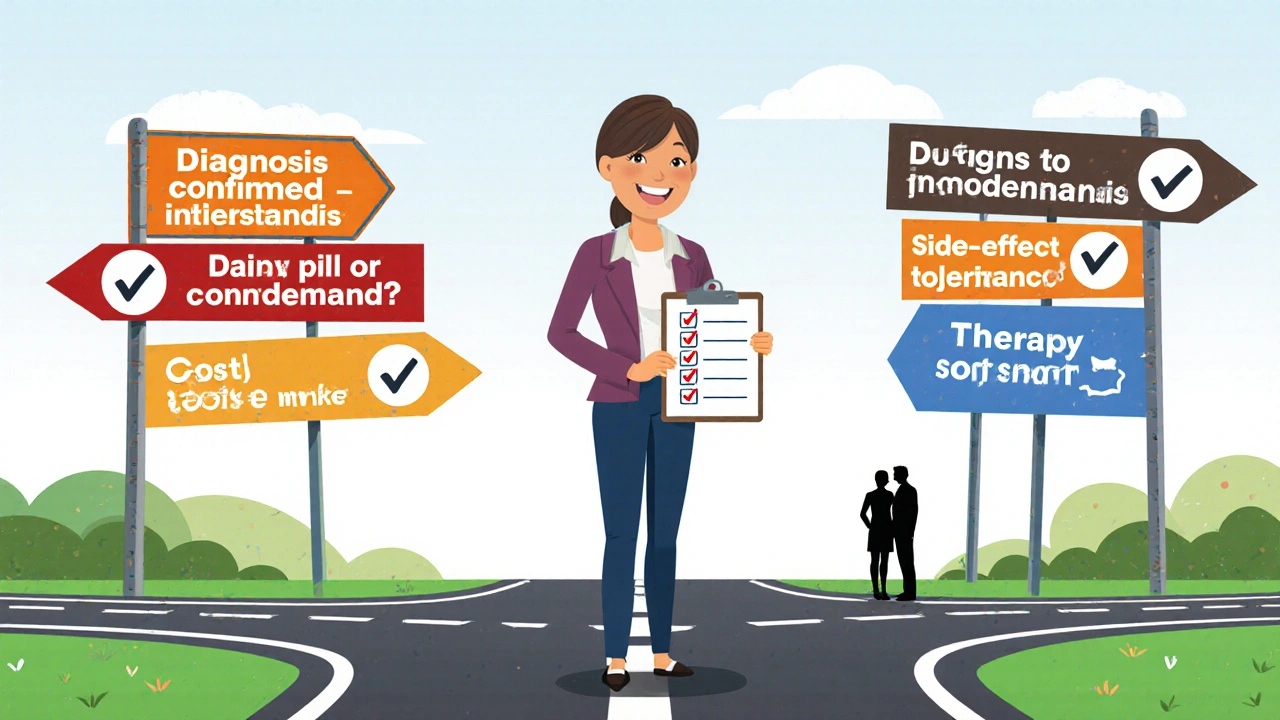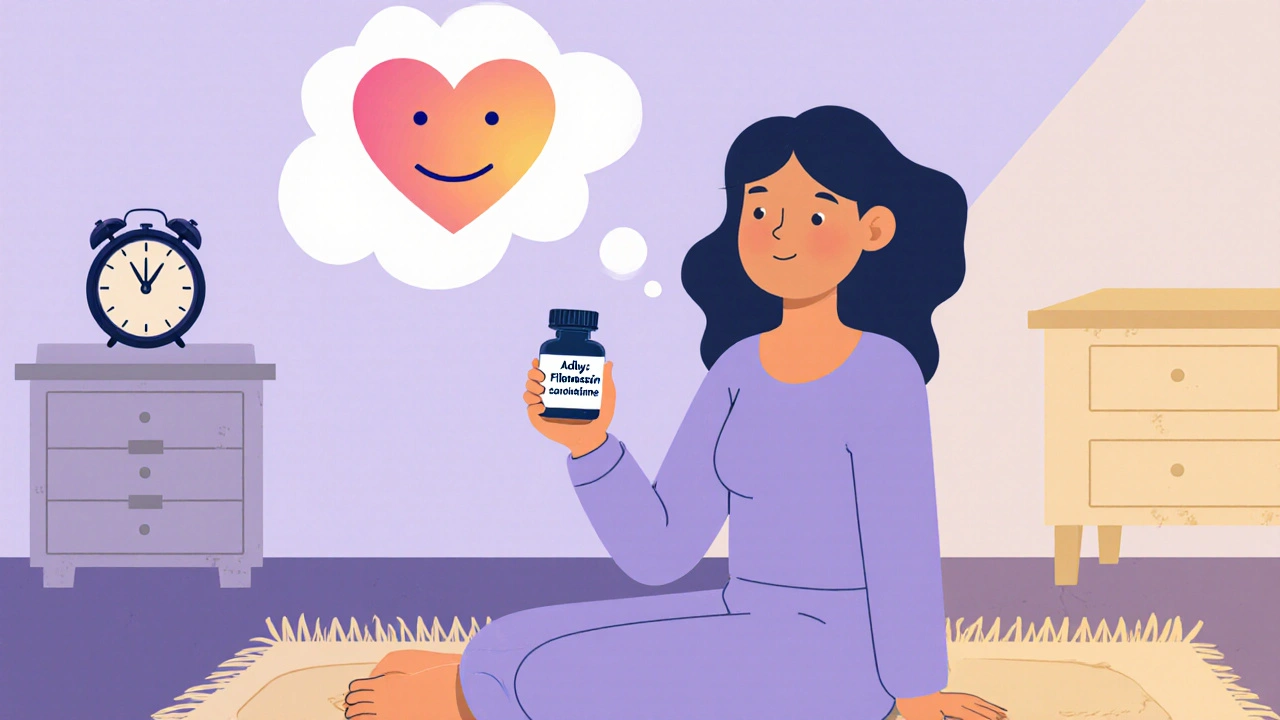Treatment Comparison Calculator
Personal Assessment
Personalized Treatment Recommendation
Best Match
RecommendedWhy this option?
Alternative Options
When it comes to low sexual desire in women, the conversation often circles back to a handful of pills and therapies. Flibanserin is the most talked‑about prescription, but it’s far from the only option on the table. Below we break down what Flibanserin does, compare it with other FDA‑approved and off‑label alternatives, and give you a practical checklist to decide which path might fit your life.
Flibanserin is a serotonergic modulator originally developed as an antidepressant and later approved by the FDA in 2015 under the brand name Addyi. It works by balancing serotonin, dopamine, and norepinephrine in the brain to boost sexual desire in premenopausal women diagnosed with hypoactive sexual desire disorder (HSDD).
How Flibanserin Works and Who It’s Intended For
Flibanserin is taken once daily at bedtime. Unlike on‑demand treatments, it aims for a steady‑state effect, gradually increasing desire over weeks. Clinical trials (e.g., the 2015 JAMA study) showed a modest 0.5‑point rise on the Female Sexual Function Index (FSFI) compared with placebo, translating to about a 20% improvement in desire scores.
The drug is approved only for premenopausal women with a clinical diagnosis of HSDD-a persistent lack of sexual interest that causes distress and isn’t explained by other medical or psychiatric conditions. It’s not for postmenopausal women, men, or anyone with uncontrolled hypertension.
Key Alternatives to Flibanserin
While Flibanserin was the first oral medication for HSDD, several alternatives have emerged, each with a different mechanism and usage pattern.
- Bremelanotide (brand name Vyleesi) - a melanocortin‑4 receptor agonist injected subcutaneously about 45 minutes before sexual activity.
- Testosterone therapy - low‑dose transdermal patches or gels used off‑label for women with low libido.
- Bupropion - an antidepressant that some clinicians prescribe off‑label because of its dopaminergic activity.
- Psychological counseling (e.g., sex therapy, cognitive‑behavioral therapy) - non‑pharmacologic, addresses relational and emotional factors.
- Placebo or watch‑ful waiting - useful in mild cases where lifestyle changes may be sufficient.
Side‑Effect Profile: Safety First
Every option carries trade‑offs. Here’s a quick rundown of the most common adverse events reported in the literature.
- Flibanserin: dizziness, sedation, nausea, and a rare risk of severe hypotension when combined with alcohol.
- Bremelanotide: injection site reactions, flushing, headache, and a spike in blood pressure shortly after dosing.
- Testosterone: acne, hirsutism, voice deepening, and potential lipid changes; long‑term safety data in women remain limited.
- Bupropion: insomnia, dry mouth, and a low incidence of seizures at high doses.
- Counseling: no pharmacologic side effects, but can be time‑intensive and may require multiple sessions.
Effectiveness in Real‑World Settings
Effect sizes differ because the drugs target different pathways. The table below compares headline results from pivotal trials and meta‑analyses up to 2024.
| Treatment | Mechanism | Typical Dosage | FDA Status | Average Desire Improvement* (FSFI) | Common Side Effects |
|---|---|---|---|---|---|
| Flibanserin (Addyi) | Serotonin‑dopamine‑norepinephrine modulator | 100 mg daily at bedtime | Approved (women, pre‑menopausal) | +0.5 points (≈20%↑) | Dizziness, nausea, sedation |
| Bremelanotide (Vyleesi) | Melanocortin‑4 receptor agonist | 1 mg subcutaneous, PRN | Approved (women, ≥18 y) | +0.7 points (≈30%↑) | Flushing, headache, BP spike |
| Testosterone (off‑label) | Androgen replacement | 300 µg patch weekly | Off‑label | +0.6 points (≈25%↑) | Acne, hirsutism, lipid changes |
| Bupropion (off‑label) | Dopamine‑norepinephrine reuptake inhibitor | 150 mg daily | Off‑label | +0.4 points (≈15%↑) | Insomnia, dry mouth, rare seizures |
| Sex Therapy (CBT) | Psychological/behavioral | Weekly 60‑min sessions | Not a drug | +0.5‑0.8 points (≈20‑35%↑) | Time commitment, cost of sessions |
*Improvement measured in randomized controlled trials; real‑world results can vary.
Cost, Accessibility, and Practical Considerations
Price is a deciding factor for many. As of 2025, the average out‑of‑pocket cost in the U.S. for a 30‑day supply is:
- Flibanserin: US$200‑250 (often covered partially by insurance with prior authorization).
- Bremelanotide: US$350‑400 per dose, making it expensive for frequent use.
- Testosterone patches: US$80‑120 per month, but off‑label use may not be reimbursed.
- Bupropion: generic options as low as US$10‑15 per month.
- Sex therapy: US$100‑150 per session, variable insurance coverage.
Insurance coverage for Flibanserin and Bremelanotide remains patchy; many insurers require documentation of failed lifestyle changes and a formal HSDD diagnosis.

Decision Checklist: Which Option Is Right for You?
- Diagnosis clarity: Have you been formally diagnosed with HSDD by a qualified clinician?
- Desired onset: Do you prefer a daily pill (Flibanserin) or an on‑demand injection (Bremelanotide)?
- Side‑effect tolerance: Are you comfortable with potential sedation (Flibanserin) or possible blood‑pressure spikes (Bremelanotide)?
- Cost constraints: Does your insurance cover any of these, or will you pay out‑of‑pocket?
- Personal health profile: Any history of hypertension, liver disease, or hormonal disorders?
- Preference for non‑drug approaches: Would you consider therapy as a first step?
If you tick most boxes for 1‑3, Flibanserin could be a reasonable start. If rapid, situational boost is essential, Bremelanotide may suit you better. Hormonal issues often point toward testosterone, while mood‑related low desire may respond to bupropion. And if you’re wary of pills altogether, counseling often yields comparable gains without pharmacologic risk.
Frequently Asked Questions
Can I take Flibanserin and alcohol together?
No. Alcohol can cause a dangerous drop in blood pressure when combined with Flibanserin, leading to fainting or dizziness. The label advises abstaining from alcohol on dosing days.
How long does it take for Flibanserin to work?
Most studies show noticeable improvement after 4‑6 weeks of consistent nightly dosing, though full effect may take up to 8 weeks.
Is Bremelanotide safe for women with hypertension?
Bremelanotide can raise systolic blood pressure temporarily. Women with uncontrolled hypertension are advised against its use.
Do testosterone patches cause masculinization?
At low doses approved for women, the risk is low, but some users report mild acne or increased body hair. Monitoring by a clinician is essential.
Can therapy replace medication entirely?
Yes, especially when low desire stems from relationship stress, trauma, or body image concerns. Many couples achieve lasting improvement without drugs.
Next Steps for Readers
1. Schedule an appointment with a healthcare provider who specializes in sexual health. Bring a symptom diary that notes frequency, context, and emotional impact of low desire.
2. Ask your clinician to run baseline labs (hormone panel, liver function, blood pressure) before starting any medication.
3. If prescribed Flibanserin, set a nightly reminder, avoid alcohol, and monitor for dizziness. Review efficacy after 6 weeks.
4. Should side effects emerge, discuss switching to an on‑demand option like Bremelanotide or exploring non‑pharmacologic routes.
5. Keep an open line with your partner. Transparent conversations often boost desire more than any pill.
Low sexual desire is a multifaceted issue, but you now have a clear map of the main pharmacologic choices, their pros and cons, and where counseling fits in. Armed with this knowledge, you can make a decision that matches your health profile, budget, and lifestyle.

The hype around Flibanserin reads like a midnight sermon for the chemically‑tuned masses, a promise that a pill can resurrect desire that society has already deemed inadequate. I argue that the drug simply masks the deeper cultural script that tells women they must be perpetually aroused for male satisfaction. Its modest effect size-about a half‑point on the FSFI-doesn’t justify the hype or the nightly dosing ritual. Moreover, the FDA’s approval feels less like a scientific triumph and more like a concession to a market that profits from insecurity. If we keep chasing serotonin tweaks, we’ll never address the relational and psychological underpinnings that truly fuel intimacy.
Great summary, really appreciate how you laid out the pros and cons of each option! 🙏 The emoji‑free table makes it easy to compare, and the checklist is super helpful for anyone feeling overwhelmed. 😊
While the article paints a neat tableau of pharmaceutical choices, one must interrogate the underlying ethos that permits a nation’s health regulators to legitimize a molecule whose primary function is to smooth the rough edges of a culturally constructed discontent. The United States, in its relentless pursuit of market‑driven solutions, has for decades turned away from the nuanced tapestry of human desire, opting instead for a one‑size‑fits‑all chemical patch. Flibanserin’s modest efficacy, as highlighted by a mere half‑point rise on the FSFI, is a testament to the limits of neurochemical tinkering when faced with the complex interplay of relational histories, power dynamics, and personal narratives. Moreover, the sheer cost-often exceeding two hundred dollars a month-creates a barrier that disproportionately affects those already marginalized, reinforcing inequities rather than alleviating them. One cannot ignore that the FDA’s approval process, while rigorous on paper, is not immune to the influence of lobbying efforts that prioritize corporate profit over patient autonomy. In contrast, the off‑label use of testosterone and bupropion, though less celebrated, offers a pragmatic approach grounded in the repurposing of well‑understood agents, yet they too suffer from a paucity of long‑term safety data in women. The injection‑based Vyleesi, with its on‑demand model, seems to acknowledge the episodic nature of desire, but its price tag and blood pressure spikes raise legitimate safety concerns. Psychological interventions, often dismissed as “soft,” actually address the root causes-communication breakdowns, trauma, and societal pressures-that no pill can resolve. In essence, the article’s checklist, while thorough, risks reducing a deeply personal experience to a series of checkboxes, inadvertently perpetuating the very medicalization it seeks to navigate. Thus, the most responsible path forward may involve a hybrid model: informed consent about pharmacologic limits, coupled with sustained investment in accessible counseling services, ensuring that desire is not merely medicated but understood, respected, and nurtured within the broader cultural context.
Yo man flibanserin is just another pill in the endless pharma parade we all get fed it promises sunrise cravings but delivers midnight yawns the hype is louder than the effect it's a circus of dopamine serotonin and hope with barely a spark of real change
Dear readers, I would like to commend the thoroughness of the preceding analysis while offering a measured perspective grounded in clinical prudence. The data presented underscores the necessity of individualized assessment, particularly when weighing the modest efficacy of Flibanserin against its potential adverse effects and financial burden. It is advisable to engage in shared decision‑making with a qualified sexual health specialist, ensuring that any therapeutic trial is accompanied by baseline laboratory evaluation and a clearly defined treatment horizon. Furthermore, integrating evidence‑based psychosexual therapy may augment pharmacologic outcomes, fostering a more holistic approach to desire restoration. I trust this reinforces the importance of a comprehensive, patient‑centered strategy.
This is exactly why you cant trust any pharma story they feed u it’s all about profit not patients and the side‑effects are hidden till you’re already in the mess 🙄
Take charge of your health, schedule that appointment today and keep a journal of how you feel-small steps lead to big changes. Remember, you control the narrative, not the pill.
The real agenda behind these meds is hidden, 🤐